Queens & Fritillaries
Nigel Venters
1: Queens
(Click on a picture to see enlargement)
1.1 Introduction
I must say I raised an eyebrow when I was given this joint subject title! Queens & Fritillaries! Wow! So very different! In fact I couldn't really think of any similarity between them apart from that both are families of butterflies, and as such fly, lay eggs, have caterpillars which turn into pupa….and so on….you know the rest!
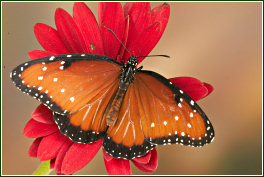 1.2 Queens are Milkweed butterflies (Danaidae)
1.2 Queens are Milkweed butterflies (Danaidae)
This heading should be titled Daniadae of the USA. Danaidae is the Latin family name of the Milkweed butterflies. There are only 4 species of Milkweed butterflies that are found in the USA …… of course everyone knows the widespread Monarch (Danaus plexippus). But unless you live in the South you are unlikely to see the other three other species, the Queen (Danaus gilippus), the Tropic Queen (Danaus eresismus) and the Tropical Milkweed Butterfly (Lycorea cleobaea). The last two species are only likely to be seen with any regularity in the extreme South of Texas.
1.3 Worldwide distribution
The Milkweed butterfly family is a very successful group and more than 300 species are found in mainly the warmer climates around the World…Asia and Africa have many species.
1.4 Migratory Monarchs.
Because you see the Monarchs every year it would be easy to think that the other three species don't migrate. In fact they do migrate, but not with the same regularity or strategy as the Monarch does. These three species are opportunist migrators, and rely on ideal conditions….rather like a Desert Locust…they take the opportunity in perfect conditions to rapidly increase their numbers….and it is this that triggers off migration. Sometimes huge numbers will build up and start off together in search of new breeding grounds. In years like this breeders living at the Northern recorded range of these species may in one year see them in large numbers after many years of never seeing a single butterfly.
1.5 Non Migratory Monarchs.
You may be interested to know that ALL of these species (Including the familiar Monarch) also produce non migratory butterflies in the Southern part of their range that spend their lives without giving the slightest consideration of migrating.
1.6 Breeding Queens
Many butterfly books give Southerly Milkweed species as the Queens foodplant ….but this food is mainly due to the butterflies restricted Southerly distribution and they ALL are quite happy on any of the Milkweed species you feed your Monarchs on. It is tempting to think that these exotic Southern species are difficult to breed…if anything they are easier…they do not have a diapause to overwinter….and if you can provide food, heat and light and you can breed these all year round! If anything they respond to warmer temperatures quite well as long as you keep the humidity high…this can result in the stages from egg to adult progressing in an amazingly short time. Just use exactly the same conditions you use for Monarchs and they will respond in exactly the same way!
1.7 A Release Butterfly?
All Monarchs/Queens are very hardy butterflies…. they can take considerable thorax damage and recover well. All Milkweed butterflies are poisonous, due to the fact they feed on Milkweed…. and birds soon learn this lesson…and leave the butterflies alone. When gripping the butterfly in their beak they soon taste the pungent cocktail of chemicals and drop them. Natural selection has furthered this butterflies defence by making them able to survive quite harsh treatment by birds that reject them.
Maybe these species are the release butterfly of the future? Climate restricts their normal range to the South, so common sense suggests there cannot be the slightest concern over releasing them further North in USA…the old adage takes over…if they could survive there now…they would already be there! So your introductions won't change a thing!
If you can get hold of the livestock you should try these species….it is fun to breed something different!
Nigel Venters 31st October 2000
2. Fritillaries
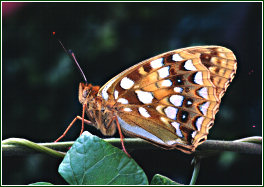
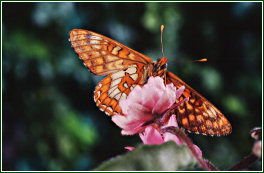
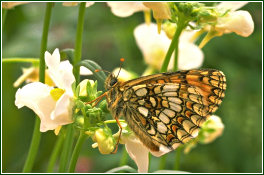
2.1 Introduction
Fritillaries are not really suited as a release butterfly, but they are so beautiful, it would be wonderful if this short text encourages someone to re-introduce a species to a previously occupied habitat or even increase an existing colony of Fritillaries. You will need to check that this is legal in your own region before you do this.
Many books separate fritillaries into Greater Fritillaries, Lesser fritillaries, Checkerspots & Crescents. And although very varied in habitat and appearance they can often be very local species inhabiting a single biotype with little or no interchange of genetic material between neighbouring groups.
Of course there are the exceptions to the rule and a few such as the Variegated Fritillary (Euptoieta claudia) migrate each year to take advantage of areas that become temporarily suited in the summer months. There is little or no reverse migration in the fall as is seen in the Monarch….so perhaps emigration is a better word to use than migration.
The Variegated Fritillary is also interesting, as unlike other fritillaries it feeds on an extremely wide range of plants including Violets and Passion flowers….and bridges the gap between the Greater and Lesser Fritillaries (Often Violet feeders) and the Longwing Fritillaries (Passionflower feeders) such as the Gulf Fritillary (Agraulis vanillae).
The Gulf Fritillary is grouped with the Longwings and is sometimes classified as a Heliconid and not a Nymphalid.
2.2 Greater Fritillaries
Greater Fritillaries can be quite common in the temperate areas. The caterpillars hide away during the daytime and feed at night on Violets. Most species have a single brood in a year and overwinter as tiny larvae or in an egg. Many larvae hatch out and start to hibernate before starting to eat any food at all!
They are usually quite easy to pair in captivity…but do give them a good-sized cage. Females will lay well in captivity, and it is useful to provide Violets as a stimulus but they generally lay their eggs on dead bracken or dead leaves and not directly on the foodplant.
Overwinter the young larvae outside in a netted box if you live in a similar climate to where you caught them. It is safer to transfer them into a sealed plastic box and overwinter them in the fridge. You can choose when spring has arrived.
2.3 Lesser Fritillaries
Lesser Fritillaries are like smaller versions of the larger fritillaries…but the often have more than one brood a year, especially in the warmer regions. The larvae most often feed on Violets…but some, especially the mountain or polar species choose low growing big plants like Cranberry. The adults almost always lay their eggs on the foodplant and they overwinter as a third instar larvae generally in a rolled up dead leaf. Not so easy to overwinter in the fridge as they are liable to either dry out or go mouldy, you need to check them often throughout the winter. Far better to overwinter outside in a netted cage if you live in a suitable climate. Trial and error will help you….but I can tell you that one species may be entirely happy in your fridge and another will have 100% mortality….you just have to document to know what to do!
2.4 Checkerspots
Checkerspots are usually the most local of all the Fritillaries, and I would urge you NOT to take too many adults from any colony they nearly always have only one brood a year..…and their colonies are often very small with no more than say 300-400 adults that emerge over a period of just a couple of weeks in a year. The strange thing about Checkerspots is they often appear to inhabit the same small patch of land year after year…even though there are similar seemingly suitable habitats only a few hundred yards away they completely ignore them. The butterfly lays large batches of eggs together and the caterpillars are gregarious…often living under a web of silk that they spin together over their foodplant. When disturbed they tumble to the ground and roll away for safety…later relocating their group within the web. They spin a thicker web to overwinter together in their third instar. They often choose Plantains (Plantago lanceolata) and members of the Aster family.
Checkerspots are usually very easy to pair and get to lay their egg batches in captivity…and do not require a cage of more than 1ft cube. it is this fact that make these delightful butterflies such a good choice for breeding for introduction.
The same problems occur for overwintering as mentioned above in Lesser Fritillaries.
2.5 Crescents.
Crescents are closely related to the Checkerspots, they too lay their eggs in clusters and the larvae are gregarious…but they do not make a web. They can often occur in huge numbers fluttering low down amongst the vegetation. They do not have such a powerful flight as the other Fritillaries. Many Crescents feed on members of the Aster family. Many species have more than one brood a year and some species can be continuously brooded in the warmer regions. Species found In the more Northern regions overwinter in their third instar.
Crescents are very easy to get to pair and lay in captivity, and they can be treated like the Checkerspots described above.
The same problems occur for overwintering as mentioned above in Lesser Fritillaries.
2.6 The Gulf Fritillary (Agraulis vanillae)
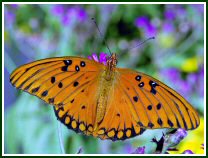 Included here because it has the common name of "Fritillary" As mention in the introduction, this is classified as a Heliconid butterfly and is part of a family with a vast number of species in South America.
Included here because it has the common name of "Fritillary" As mention in the introduction, this is classified as a Heliconid butterfly and is part of a family with a vast number of species in South America.
This species is either an opportunist emigrator…(Little evidence of a return journey) or continuously brooded in the warmest parts of the USA. It feeds on Passionflower (Passiflora) and one of the best species to feed it is the hardiest Passionflower of them all…(Passiflora caerulea) This plant can take quite severe frosts down to minus 5C.
The Gulf Fritillary is very easy to breed, they pair and lay very well in captivity and will keep producing successive broods under lights as long as you can provide warmth and foodplant.
Nigel Venters 1st November 2000


